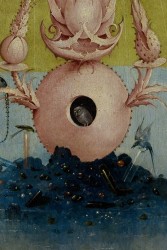
Boczkowska 1977
“The Crab, the Sun, the Moon and Venus: studies in the iconology of Hieronymus Bosch’s triptych The Garden of Earthly Delights” (Anna Boczkowska) 1977
[in: Oud Holland, vol. 91 (1977), nr. 4, pp. 197-231]
[Also mentioned in Gibson 1983: 84-85 (E74)]
In this article the author introduces new material for her hypothesis that the iconography of the Garden of Delights is based on astrological-alchemical symbols and ideas which define the religious symbolism of the triptych. In the lower part of the Fountain of Life on the left wing Boczkowska recognizes a crab or a lobster which is composed of the signs of the Sun and the Moon. At the same time this lower part forms a well-known alchemical ideogram for the coniunctio oppositorum, usually described as coniunctio Solis et Lunae. But this detail can also be interpreted in a religious way as the marriage of Christ (as Second Adam or Sun) to Ecclesia (= Eve or the Moon). On the left wing this marriage is depicted below the Fountain of Life and it is the main theme of the triptych, which was probably painted for a couple of newly-wed patrons in the year 1504, when there was a conjunction of Sun and Moon in the sign of Cancer. The man and the woman in the bottom right corner of the central panel are identified by the author as these newly-weds.
The central panel of the triptych represents the Paradise of Ecclesia and for this Bosch made use of profane motifs such as the garden of love, the fountain of youth or of love, and the children of the planets (more precisely: the children of the Moon and of Venus). The central panel is a praise of woman, love, motherhood and procreation. The right wing should be interpreted as an antithesis to the Paradise of Ecclesia: here Bosch painted a vision of earth undergoing the negative influence of Venus and the Moon.
Although Boczkowska, using astrology and alchemy as a starting-point, says some remarkable things about certain details of Bosch’s triptych, her general interpretation of the triptych shows a number of flaws and improbabilities. It may be possible that Bosch used some astrological and alchemical images, but interpreting the whole triptych in a positive-astrological way is a bridge too far. Especially the relation between the central panel and the right wing is a weak link in Boczkowska’s chain of thoughts.
[explicit]